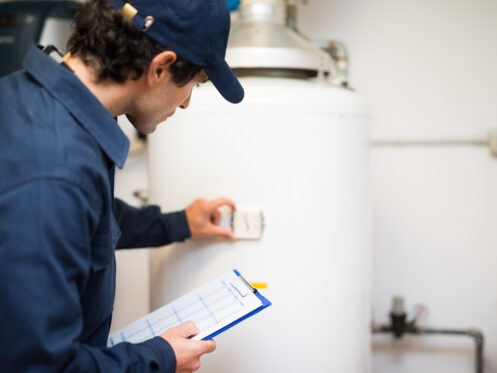A leaky water heater is never something you should ignore. Although a minor leak may not seem like a huge issue, there is a chance that a water heater tank will burst depending on what is causing it to leak. That’s why it’s important that you take steps to determine where the leak is coming from and know what to do if your water heater ever starts leaking.
How to Determine Why Your Water Heater Is Leaking
If you ever notice a wet spot on the floor near your water heater or water pooling around it, you need to take immediate action. That means trying to locate the source of the leak since this can often help you determine why the unit is leaking. A tank water heater will usually leak from one of five different places.
The first two are the pipe fittings where the cold water inlet pipe and hot water outlet pipe connect to the pipes that stick up through the tank. You can easily check to see if either of these fittings is leaking by feeling them to see if they’re wet. If the cold water fitting is leaking, water will just continue dripping out. If the leak is in the hot water pipe fitting, usually only a small amount of water will drip out other than when you have the hot water running at any fixture in your home.
The next place where a tank water heater can leak is the temperature-and-pressure relief (T&P) valve. This valve is a vital safety feature found on all tank water heaters. Its purpose is to ensure that the tank doesn’t explode, which could happen if the pressure inside it gets too high. When the pressure inside the tank increases above a certain amount, it basically forces the valve open. This results in some water draining out so that the pressure inside the tank quickly decreases back to a safe level. The T&P valve is located on the side of the tank near the top of the water heater, which means the side of the unit below the valve will be wet if the valve opened recently.
Water can also sometimes start dripping out of the drain valve near the bottom of the water heater tank. This valve is obviously what’s used to drain the water heater so that all of the sediment build-up can be flushed out of the tank. The most common reason that this valve will leak is simply that you or a plumber didn’t fully close it after flushing your water heater. This is something you can check for by trying to turn the handle on the valve clockwise. If you can get it to turn and the water stops dripping out, you have nothing to worry about. If it won’t turn or keeps leaking, it indicates that the internal seal in the valve is worn out and you need to hire a plumber to replace the valve.
The last place that a water heater can leak from is the tank itself. In this case, you should be able to see water dripping out underneath the tank or possibly from a spot on any side of the tank.
What to Do If Your Water Heater Is Leaking
You generally always want to contact a plumber immediately any time your water heater starts leaking. The only time you won’t need a plumber’s help is if the unit was only leaking because the drain valve wasn’t fully closed.
If either the hot or cold pipe is leaking, the plumber will either need to re-solder the fitting or possibly replace the section of the pipe that connects to the water heater. This is a fairly easy fix that can sometimes be done without having to shut off and drain your water heater. However, it depends on whether the hot or cold pipe is leaking. To fix a leak in the hot water pipe, a plumber just needs to shut off the valve on the pipe so no more hot water can flow out of the water heater. They’ll then turn on the hot water in a sink to drain all of the water out of the pipe that connects to the unit. Fixing a leak in the cold water pipe requires shutting off the water to your house by closing the main shut-off valve. The plumber will then need to drain the water heater so that the remaining water in the pipe that feeds the unit also fully drains.
Fixing a leak caused by a faulty or worn-out drain valve or T&P valve is simple. All the plumber needs to do is drain the tank so that they can remove the old valve and install the new one. The T&P valve should generally never open and allow water to leak out unless your water heater isn’t working correctly. The hotter the water in the tank gets, the greater the pressure will be. That means that if the T&P valve keeps opening, it means that your water heater is heating the water too much. This usually happens because the water heater’s thermostat is broken or malfunctioning, leading to the unit staying on and heating longer than it should.
The one situation where you really need to worry is if water is leaking from the tank itself. This indicates that the tank has started to rust through and is no longer fully sealed. In this case, you should immediately shut your water heater off and close the valve on the cold water pipe. You then want to start running the hot water in a few sinks or showers so that you can quickly drain the tank.
The reason why you want to act immediately is that if the shell of the tank is compromised due to rest, the pressure of the hot water will often cause the tank to completely rupture at some point. That means you could end up with 40 to 80 gallons of hot water suddenly rushing out and creating a major flood in your home. Unfortunately, your old option if the tank itself is leaking is to replace the water heater since this type of leak can’t be repaired.
How Water Heater Maintenance Can Help Prevent Leaks
Hiring a plumber to maintain and service your water heater at least yearly can help you avoid issues with leaks and many other common problems. It will also ensure your water heater still functions efficiently so that your energy bills don’t start increasing. One of the most important tasks the plumber will perform is draining and flushing the tank to get rid of all of the sediment. Sediment build-up increases the chances of a water heater eventually leaking. The reason is that the sediment layer absorbs lots of heat, which can create hot spots that start to weaken the steel tank.
Another essential task is for the plumber to check the condition of the anode rod inside the tank to see if it needs to be replaced. The dissolved minerals in the hot water inside the tank are somewhat corrosive, which means they would normally react with the steel the tank is made of and begin causing it to rust and corrode. The anode rod prevents this from happening or at least lessens the effect.
The reason is that it has a thick coating of either aluminum, magnesium or an aluminum/zinc alloy, all of which are much more reactive than steel. That means that instead of the minerals in the water corroding the tank, they react with the metal coating on the anode rod and basically eat away at it over time. At some point, the coating will completely dissolve and the minerals will then begin eating away at the tank and causing it to rust and corrode. That’s why it’s important to replace the anode rod every three to five years or so since it helps to prevent the tank from rusting and eventually leaking.
If your water heater is leaking or you need to get it repaired or maintained, you can trust the experts at Erica's Plumbing, Air Conditioning & Restoration for help. We offer tankless water heaters, too! We’re a women-owned company that’s been serving the Boca Raton area since 2009, and our team is ready to expertly handle all of your plumbing, drain, sewer and air conditioning needs. To schedule a consultation or service call, contact us today.

